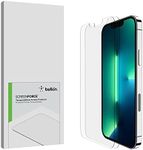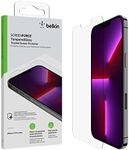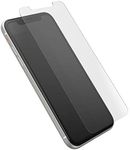Buying Guide for the Best Iphone Glass Screen Protectors
Choosing the right glass screen protector for your iPhone is important to keep your device safe from scratches, cracks, and everyday wear. With so many options available, it can be overwhelming to know what to look for. The key is to focus on the features that matter most for your lifestyle and usage habits. Understanding the main specifications will help you make a confident choice that balances protection, clarity, and ease of use.Material QualityMaterial quality refers to the type of glass or composite used in the screen protector. Most high-quality protectors use tempered glass, which is specially treated to be stronger and more resistant to shattering. This is important because a better material will offer more reliable protection against drops and scratches. When comparing options, look for terms like 'tempered glass' or '9H hardness.' Lower quality materials may be cheaper but can scratch easily or not absorb impacts well. If you are prone to dropping your phone or want the best protection, prioritize higher quality materials.
ThicknessThickness is measured in millimeters (mm) and usually ranges from about 0.2mm to 0.5mm. Thicker protectors generally offer more impact resistance, but can feel bulkier and may affect touch sensitivity. Thinner protectors are less noticeable and feel more like the original screen, but may not provide as much protection. If you want maximum protection, go for a thicker option. If you prefer a natural feel and minimal look, a thinner protector might be better for you.
Clarity and TransparencyClarity and transparency describe how clear the screen looks with the protector on. High clarity means your screen will look bright and colors will be accurate, while lower clarity can make your display look dull or blurry. Some protectors have special coatings to reduce glare or fingerprints, which can also affect clarity. If you use your phone for watching videos or editing photos, choose a protector with high transparency. If you mostly use your phone for calls and texts, this may be less important.
Oleophobic CoatingAn oleophobic coating is a special layer that helps resist fingerprints, smudges, and oil from your skin. This keeps your screen looking clean and makes it easier to wipe off marks. Not all protectors have this feature, and it can wear off over time. If you often find your screen getting dirty or you want to minimize cleaning, look for a protector with a strong oleophobic coating.
Edge DesignEdge design refers to how the protector fits around the edges of your iPhone screen. Some have flat edges, while others are curved (sometimes called 2.5D or 3D edges) to better match the shape of the phone. Curved edges can feel smoother and offer more complete coverage, but may be more expensive. If you want full edge-to-edge protection and a seamless feel, choose a curved edge design. If you use a case that covers the edges, a flat edge protector may be sufficient.
Touch SensitivityTouch sensitivity is how well the screen responds to your touch with the protector on. A good protector should not interfere with normal use, but some thicker or lower quality options can make the screen less responsive. If you play games or use apps that require precise touch, make sure to choose a protector that promises high touch sensitivity.
Installation MethodInstallation method refers to how easy it is to apply the protector without bubbles or misalignment. Some protectors come with installation kits or frames to help you line things up perfectly. If you are worried about installing it yourself, look for options that include easy-apply tools or clear instructions. If you are comfortable with DIY tasks, this may be less of a concern.















